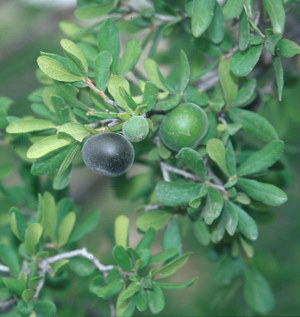Texas Persimmon, Mexican Persimmon, Chapote
Diospyros texana, Scheele
Ebenaceae (Persimmon Family)
Texas persimmon is a small hardwood tree with simple, leathery, evergreen leaves. It has distinctive, smooth, light gray bark that peels from the more mature trunks or stems. Its astringent fruit was used for food and medicine, while its tough wood was used to make digging sticks.
The diminuitive flowers are usually unisexual and dioecious, which means that some trees are staminate (male, pollen producing) and some pistillate (female, fruit bearing). The fruit, a berry or berry-like measuring 1/2 to1-inch in diameter, ripens to a black color, contains about 5-8 seeds, and has a dark, sweet, acidic pulp. Texas persimmon is widespread throughout the Lower Pecos Canyonlands.
Archeological occurrence. Almost every dry midden deposit in every sheltered site in the region contains thousands of persimmon seeds, testimony to the widespread consumption of the fruit (Alexander 1974; Dering 1979; Irving 1966). Additionally, there are at least two digging sticks in collections made from Texas persimmon, one from Hinds Cave, and one from the Shumla Caves expedition. The Hinds Cave digging stick is in a private collection, and the Shumla Caves example is displayed at the Witte Museum, San Antonio.
Food and medicine. Texas persimmon is a rare case where the weight of the archeological evidence for indigenous use far outstrips the ethnographic documentation. While archeological specimens abound, there is only one mention of Texas persimmon in the ethnographic literature, and it is listed under the obsolete name, Brayodendron texanum. The authors briefly mention that the Comanche ate the fruits raw (Carlson and Jones 1940:520).
The fruit of Texas persimmon is quite similar to that of eastern persimmon (Diospyros virginiana), and the uses were probably quite similar as well. A brief examination of the ethnography of eastern persimmon suggests other possible uses of the Texas persimmon.
Perhaps most important is the use of the fruit as an astringent for treating sores in the throat and mouth, practiced by the Cherokee (Hamel and Chiltoskey 1975:49). They also used that quality of the fruit to treat hemorrhoids. Texas persimmon is even more astringent and acidic than eastern persimmon, a characteristic this author learned on a hot August afternoon. Hiking, hot, and out of water, this author (then a graduate student) decided to eat several persimmons to slake his thirst. This was not a good idea, because his mouth felt drier for the trouble, and his stomach, empty of water, had a problem with the acidic quality of the persimmons, which resulted in the discovery of the emetic qualities of the fruit. This application is not mentioned in the ethnographic record, but no further confirmation is needed.
References:
Alexander, Robert K.
1974 The Archeology of Conejo Shelter: A Study of Cultural Stability at an Archaic Rockshelter Site in Southwestern Texas. Ph.D. dissertation, University of Texas at Austin. Austin, Texas.
Dering, J. Philip
1979 Pollen and Plant Macrofossil Vegetation Record Recovered from Hinds Cave, Val Verde County, Texas. Masters Thesis. Pulblished by the Department of Anthropology. Texas A&M University. College Station, Texas.
Carlson, Gustav G. and Volney H. Jones
1940 Some Notes on Uses of Plants by the Comanche Indians. Papers of the Michigan Academy of Science, Arts, and Letters 25:517-542.
Hamel, Paul B. and Mary U. Chiltoskey
1975 Cherokee Plants and Their Uses -- A 400 Year History. Herald Publishing Co., Sylva, N.C.
Irving, Robert S.
1966 A Preliminary Analysis of Plant Remains from Six Amistad Reservoir Sites. In A Preliminary Study of the Paleoecology of the Amistad Reservoir Area, ed. by Dee Ann Story and V. M. Bryant, Jr., pp. 61-90. National Science Foundation Final Report (GS-667).
![]()
